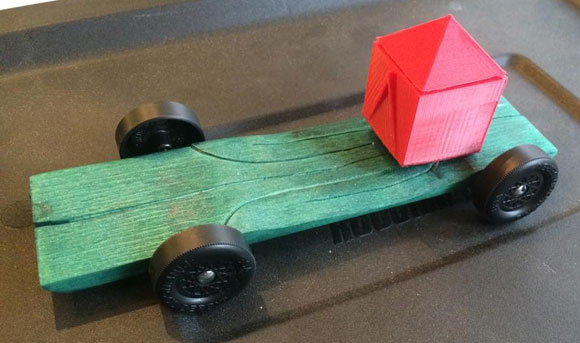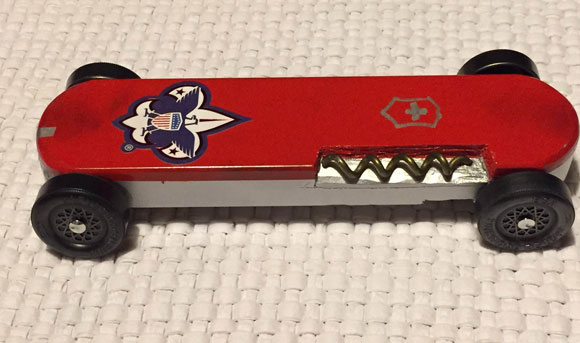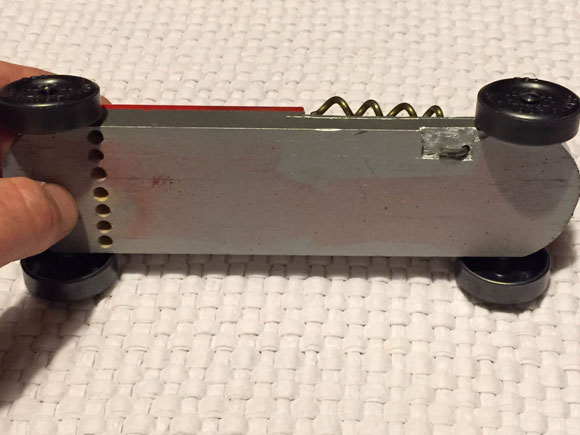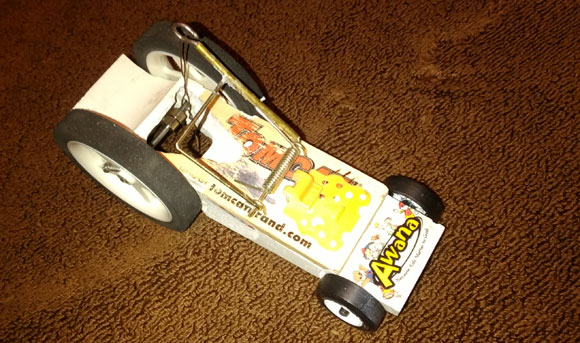
Truck


Truck
 Truck |

|
 Truck |
 Please include your full name. If selected, we will include the
photo and description in this newsletter. Please include your full name. If selected, we will include the
photo and description in this newsletter.
Photos must be sent by e-mail in JPG format (minimum size of 640x480, maximum size of 1280 x 960). Please shoot photos from the front left of the car, similar to the orientation of this car. For better focus, keep the camera four or five feet away from the car, and then use the camera's zoom to fill the frame with the car. Also, use a solid (preferably white) background for the photo. Send only one photo per car, unless an additional photo is needed to adequately show a feature. Thanks. "(If you cut off a piece from the back and glue it to the front) it is best to make sure that the wood grain is exposed so the inspector can see that it is a new piece of wood glued on and not an intact block of wood with just new slots cut. (As an inspector) I will allow glued on portions but not just re-cut slots; it is the principle of the thing." |
|
 
If you are planning a race and are not required to use a specific kit type, our MV Basic or Wedge Car Kit are just what you need. These attractively priced kits are equipped with:
|
 1. The box for the Revell '34 Ford Street Rod model. Our kit was part of the Revell, Make 'N' Take kit so it came in a plastic bag. |
 2. The contents of the kit minus the instructions. The only parts we will be using are the body, fenders, interior and some of the chrome bits (about 75% to 80% of the kit). |
 3. The width of the model body is 2 11/16 inches. |
 4. The length is 6 3/8 inches. We will be making the car to the standard 7 inch lenghth. This will allow the weight to be placed higher up on the track to give us more potential energy. |
 5. Turns out the wheelbase measures 4 3/8 inches, just like the standard pinewood derby car wheelbase. |
 6. The axles line up perfectly to a pinewood derby block. |
 7. Using the model chassis, I added the pinewood derby wheels to the axles provided with the model to see if the wheels would look right within the model fenders. At this point I think it looks right on. |
 8. The car could also be built fenderless. This would be more difficult as the wooden frame would be harder to cover up. |
 9. Here is the plan I drew based on the frame of the model. The chassis should make the wheels fit snuggly within the fenders. |
 10. The plan and the standard block with wheelbase dimensions drawn on. We are allowed to drill our axle holes. The rear axles will be drilled at a 2.6 degree angle for rail riding. The front-left axle is raised. |
 11. The axles were drilled using the Pro Body Jig tool (this could also have be done with the Pro Body tool). |
 12. Drilled block and car body. |
 13. All of the saw cuts have been made on our modified pine chassis, you can see the lines that have been scored so the remaining wood can be removed with a wood chisel. |
 14. Here is the rough carved chassis with the wheels mounted. |
 15. This is one of the body fit tests. The chassis must be modified to get the wheels to sit even with the fenders. The trick is to get the raised front wheel to look good along with the rest of the wheels. At this point the body, chassis, wheels and axles weigh 2.71 ounces. |
 16. During the mock up, the front wheel frame horns need to be cut out. This picture shows the frame horns and what they looked like after they were trimmed. |
 17. Here are the wheel clearances when the chassis is complete. All wheel clearances were checked to make sure they are even and the wheel is not dragging on the fenders. All clearances look good! |
 18. The chassis filled and ready to be sanded smooth. |
 19. The chassis is sanded and primed. The primer will be sanded smooth before the chassis is painted semi-gloss black. |
 20. Originally I was planning to glue the car body to the pine chassis, then I decided to use the holes provided to attach the body and fenders to the plastic frame. Using a pinewood derby axle I marked the holes where the screws hold the body to the model chassis. I drilled the holes through the wood frame with a 1/8 inch drill bit. I measured and determined the body could be held with 4-40 screws, as the provided screws were not long enough. |
 21. I stopped at a hardware store to purchase some 4-40 screws. I measured and figured I could attach the body with 4-40 X 3/4 inch (rear) and a 4-40 X 1 inch (front) screws. I bought the screws in stainless steel for 61 cents. |
 22. I had a 4-40 tap and drill set. They are available for about $5 at most hardware and home stores. These are pictured along with the 1 and 3/4 inch SS screws. |
 23. The mounts in the body were drilled out with the bit. I placed the drill bit next to the plastic mount and applied tape to the bit so that I knew when to stop drilling. I used a pin vise to drill the holes out. The tap is used by hand to make the threads in the hole; you may want to use tape to make sure the tap doesn't go too far. |
 24. The screws are flat heads so I used a drill bit, by hand, to make a countersink so the screws mount flush with the bottom of the car. Flat head screws also keep the bottom flat, which aids in stopping the car. |
 25. The countersink was easily fixed with a Sharpie marker. |
 26. I decided to paint the body a metallic copper color. |
 27. While the paint was drying I worked on detailing the interior. |
 28. Shown are all of the pieces awaiting assembly. The weight is 3.71 ounces. |
 29. I could have added 1-1/4 ounces of tungsten to the rear of the car, but decided to use lead. I encapsulated the lead in aluminum tape. |
 30. Complete car, ready to race. |
 31. You can see the raised front wheel in this picture, you can also see the cambered rear wheel. |
 32. Ready to race, weight. |
Growing up is mandatory; growing old is optional.
Forget the health food. I need all the preservatives I can get.
When you fall down, you wonder what else you can do while you're down there.
You're getting old when you get the same sensation from a rocking chair that you once got from a roller coaster..
It's frustrating when you know all the answers but nobody bothers to ask you the questions.
Time may be a great healer, but it's a lousy beautician.
Wisdom comes with age, but sometimes age comes alone.

|
Indy Roadster Kit Additional 10% Off |

|





Use the cumulative fastest time - the lowest of the sum of the regulation heats.
Have a best of three heat runoff (this is what we do). We have tokens for each of the four lanes, and the kids pull tokens out of the cup for lane selection for the first heat. In the second heat the lanes are swapped. If a third heat is needed, then tokens are drawn again.
